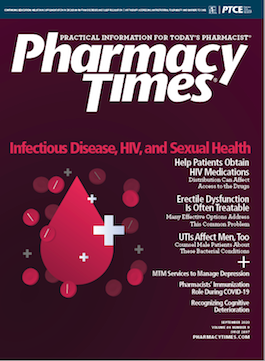Publication
Article
Pharmacy Times
Counsel About the Appropriate Use of At-Home HIV Tests
Author(s):
Although HIV self-tests are available for retail purchase by consumers, the CDC encourages health departments to consider self-testing as an additional strategy to reach individuals most affected by the virus.
The CDC reports that an estimated 1.1 million individuals 13 years and older live with HIV, including about 162,5000, representing approximately 15% who have yet to be diagnosed.1
The FDA conducts regulation of the tests for detecting HIV and approved options that can be used to test for the virus. These choices include (1) a patient collects a sample, mails it to a medical laboratory, and trained medical professionals run the test in the lab; (2) a patient collects a sample, performs a test, and obtains results at home; or (3) trained health professionals collect a sample and perform the test in a professional medical setting to obtain results.2
Although HIV self-tests are available for retail purchase by consumers, the CDC encourages health departments to consider self-testing as an additional strategy to reach individuals most affected by the virus.3
At-home testing kits can be advantageous because they provide convenience, privacy, quick results, and are sometimes cost-effective, according to the FDA.3
The at-home HIV diagnostic kits detect antibodies to the virus.4 Because 3 weeks to 6 months may be warranted for an exposed individual to develop sufficient antibodies, the time of possible exposure to HIV must be taken into consideration to ascertain the proper time to take the tests.5
To date, there are 2 at-home HIV diagnostic test kits on the market: the Home Access HIV-1 Test System and the OraQuick In-home HIV test.5-8
The Home Access HIV test, which is available as express and standard mailing testing kits, requires a finger stick blood sample. The sample is then mailed to a testing center to obtain the results.9 OraQuick is a saliva-based testing kit that provides results in the home in 20 minutes. The test offers 24-7 confidential call center support and requires a quick oral swab.8
Since the approval of at-home HIV test kits, the FDA predicted that their availability could benefit public health by assisting more patients who are infected in becoming aware of their HIV status, thus possibly diminishing virus transmission.10 The FDA also noted that these at-home tests are targeted to individuals who would otherwise not be tested because of concerns regarding a lack of confidentiality and privacy.10
Pharmacist Role
As front-line health care providers, pharmacists are in a key position to remind patients that although at-home kits have advantages, they can also have drawbacks if used incorrectly. To obtain accurate results, counsel patients about adhering to the testing protocol, storage of the testing kit before testing, proper sample collection, and shipment of testing kits that warrant mailing. Remind patients to only use FDA-approved testing kits and when in doubt to always seek counsel from a pharmacist or primary health care provider. During counseling, always encourage patients to follow up with their primary health care providers if they have concerns, as early detection and treatment are crucial. The manufacturers of both testing kits encourage patients to contact their 24-7 confidential support lines to answer questions and to contact their primary health care providers to confirm results, regardless if the test result is negative or positive. Pharmacists should also encourage patients to investigate the numerous educational resources available about HIV, including modes of transmission, preventive measures, risk factors, and treatments. Through patient education, pharmacists can empower patients by providing them with information to prevent or reduce HIV transmission.
REFERENCES
- Statistics HIV/AIDS. Centers for Disease Control and Prevention. Updated May 18, 2020. cdc.gov/hiv/statistics/overview/index.html. Accessed May 20, 2020.
- Testing for HIV. US Food & Drug Administration. Updated March 23, 2018. https://www.fda.gov/vaccines-blood-biologics/hiv-home-test-kits/testing-hiv. Accessed April 7, 2020.
- HIV self-testing. Centers for Disease Control and Prevention. Updated May 15, 2020.cdc.gov/hiv/testing/self-testing.html. Accessed May 20, 2020.
- Home use tests. US Food & Drug Administration. Updated April 14, 2019. https://www.fda.gov/medicaldevices/productsandmedicalprocedures/invitrodiagnostics/homeusetests/default.htm. Accessed April 7, 2020.
- HIV/AIDS spotlight. Centers for Disease Control and Prevention.wwwnc.cdc.gov/eid/spotlight/hiv. Accessed May 20, 2020.
- Briggs G. Home testing and monitoring devices. In: Krinsky D, Berardi R, Ferreri S, et al, eds. Handbook of Nonprescription Drugs. 19th ed. American Pharmacists Association; 2018.
- In-Home HIV Test. OraQuick.oraquick.com/What-is-OraQuick/OraQuick-In-Home-HIV-Test. Accessed April 7, 2020.
- Information regarding the OraQuick In-Home HIV Test. US Food & Drug Administration. Updated February 2, 2018. https://www.fda.gov/BiologicsBloodVaccines/BloodBloodProducts/ApprovedProducts/PremarketApprovalsPMAs/ucm311895.htm. Accessed April 7, 2020.
- HIV-1 Test System. Home Access Health Corporation. https://www.homeaccess.com/hiv_test/. Accessed May 20, 2020.
- At-home HIV testing: educating patients. American Pharmacists Association. Published March 1, 2013. pharmacist.com/home-hiv-testing-educating-patients. Accessed April 7, 2020.







